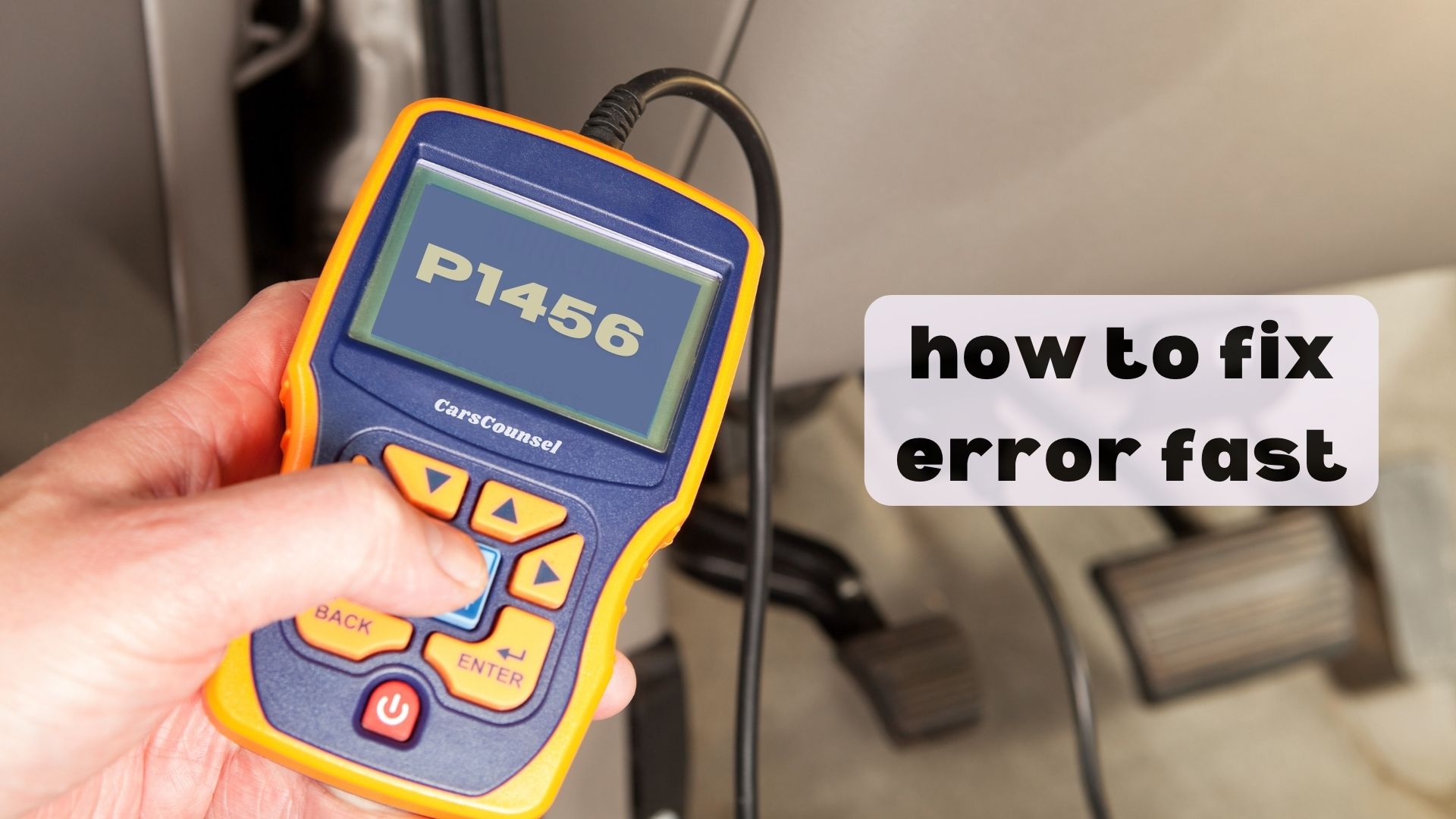Imagine driving down the highway, the sun shining bright, when suddenly your “Check Engine” light flickers on, casting a shadow of uncertainty over your day. You’ve got a P1456 code, and it’s not just a minor annoyance – it’s a sign of a small leak in your Evaporative Emission Control system. But don’t worry, you’re on the right track to diagnosing the issue.
As you dig deeper, you’ll uncover common culprits like a faulty fuel filler cap or malfunctioning EVAP components, and we’ll guide you through the process of tracking down the root cause.

Quick Navigation
Key Takeaways
- The P1456 code indicates a small leak in the Evaporative Emission Control (EVAP) system, compromising emissions and fuel efficiency.
- Common causes include a missing or faulty fuel filler cap, incorrect cap used, or a leak in EVAP system components like the two-way valve or canister.
- Symptoms may include the “Check Engine” light, fuel odor, and failed emissions tests, which can lead to decreased fuel efficiency and increased fuel costs.
- To fix the issue, check the fuel filler cap, inspect related wiring and EVAP system components, and perform a thorough vehicle inspection using diagnostic tools.
- Additional resources like repair guides, factory service manuals, and online forums can provide detailed instructions and insights to diagnose and repair the P1456 code.
Fix Your Car Smarter
When dealing with the P1456 code, utilizing the right tools and resources can make a significant difference in efficiently diagnosing and repairing the issue.
You’ll want to try the new AutoCodes App for complete OBDII diagnostics, repair solutions, and cost estimates, plus AI chat support on demand.
This will help you take control of your car maintenance and adopt smarter driving habits. With the app, you’ll get accurate diagnostics and repair solutions, allowing you to fix your car more efficiently.
Possible Causes
The P1456 code can be triggered by several factors, including a missing fuel filler cap, an incorrect fuel filler cap used, or a fuel filler cap that remains open or fails to close.
These fuel cap issues can cause vapor leaks, leading to the error code. Additionally, you may have foreign matter caught in the fuel filler cap, which can also trigger the code.
Faulty EVAP components, such as the two-way valve, bypass solenoid valve, or canister, can also be the culprit. Make sure to check these possible causes to diagnose and fix the issue.
Tech Notes
A faulty fuel tank filler cap is often the culprit behind the P1456 code.
You’ll want to check it first before diving deeper into the issue.
The EVAP control system stores fuel vapor from the fuel tank in the EVAP canister.
The onboard refueling vapor recovery system (ORVR) stores fuel vapor generated when refueling.
The EVAP control system leak detection method improves accuracy and frequency of detection.
Retightening the fuel tank filler cap and erasing the code may repair the problem.
Description and Symptoms
You’re dealing with a P1456 code, which means your EVAP system has a very small leak.
This code is triggered when the system detects a tiny fuel leak, which can lead to fuel vapor release and a noticeable fuel odor.
When this code is set, your “Check Engine” light will come on.
During vehicle inspections, it’s essential to identify and address fuel leaks to prevent further damage.
A small leak may not seem like a big deal, but it can still cause issues and affect your vehicle’s performance.
How to Fix
Now that you’ve identified the P1456 code and understand its symptoms, it’s time to take action and fix the issue.
Take control of your vehicle’s health: it’s time to diagnose and repair the root cause of the P1456 code.
To improve your vehicle’s fuel efficiency and prevent further damage, follow these steps:
- Check the fuel filler cap for any damage or blockages and verify it’s properly closed.
- Inspect the related wiring harness and connectors for any signs of damage or corrosion.
- Visually examine the EVAP system components, such as the two-way valve and bypass solenoid valve, for any signs of malfunction.
- Perform a thorough vehicle inspection to identify any other potential issues that may be contributing to the problem.
Additional Resources
Repair guides and factory service manuals can provide valuable insights and detailed instructions for diagnosing and fixing the P1456 code.
You can also access online resources like Auto Repair Forums, where you can discuss the issue with other car owners and mechanics.
Additionally, consider investing in Diagnostic Tools, such as the New AutoCodes App, which offers complete OBDII diagnostics, repair solutions, and cost estimates, plus AI chat support on demand.
These resources can help you troubleshoot and fix the P1456 code efficiently and effectively.
P1456 Code Meaning
The P1456 code indicates a very small leak in the Evaporative Emission Control (EVAP) system, which is responsible for storing fuel vapor from the fuel tank in the EVAP canister and preventing it from escaping into the atmosphere.
A small leak in the EVAP system allows fuel vapor to escape, compromising emissions and fuel efficiency.
This leak can affect your vehicle’s fuel efficiency and overall performance. To maintain your vehicle’s peak condition, it’s essential to address this issue promptly.
- The EVAP system plays a vital role in vehicle maintenance, as it helps reduce emissions and prevent fuel vapor from escaping.
- A small leak in the EVAP system can lead to decreased fuel efficiency, which can increase your fuel costs.
- Ignoring this issue can lead to more severe problems down the road, such as damage to other components.
- By addressing the P1456 code, you can guarantee your vehicle runs smoothly and efficiently.
Causes, Symptoms, and Tech Notes
When your vehicle’s onboard computer detects a very small leak in the Evaporative Emission Control (EVAP) system, it triggers the P1456 code.
This code typically indicates a minor issue, but it’s essential to address it to prevent fuel leaks and emissions problems.
Common causes include a missing or loose fuel filler cap, faulty EVAP valves, or foreign matter caught in the cap.
Symptoms may include the Engine Light turning on, a fuel odor, or failed emissions tests.
The EVAP system’s fuel leak detection method is designed to improve accuracy and frequency of detection, ensuring your vehicle runs efficiently and environmentally friendly.
More OBD-II Codes
| C1204 | C1203 | P1457 | P1491 |
| P1773 | P1783 | P1788 | P1002 |
| P1003 | P1013 | P1014 | P1015 |
| P1016 | P1018 | P1498 | P1656 |
| P1658 | P1666 | P1768 | P1668 |
| P1738 | P1739 | P1753 | P1758 |
Frequently Asked Questions
Can a Loose Fuel Cap Cause the Check Engine Light to Come On?
You’re wondering if a loose fuel cap can trigger the check engine light. Yes, it can! A loose or faulty fuel cap can cause evaporation system leaks, leading to the check engine light. Perform a fuel cap inspection and maintain your fuel system to prevent this issue.
Will the P1456 Code Clear Itself if I Fix the Problem?
Like a lingering shadow, the P1456 code won’t magically disappear; you’ll need to erase it manually after fixing the issue. The code’s persistence relies on fault tolerance, so once you’ve resolved the problem, use a code scanner to clear it, ensuring the check engine light’s demise.
How Long Does It Take to Repair the EVAP System Leak?
You’ll typically spend 30 minutes to an hour inspecting the EVAP system and using leak detection tools to identify the source of the leak, then another 30 minutes to an hour repairing or replacing the faulty component.
Is It Safe to Drive With the P1456 Code Active?
You’re tempting fate by driving with a P1456 code active, risking a catastrophic fuel leak, and watching your fuel efficiency plummet. Don’t take the wheel until you address this issue, or you might find yourself stranded, wasting gas, and courting disaster.
Can I Use a Scanner to Diagnose EVAP System Leaks?
You can use a scanner to diagnose EVAP system leaks by running EVAP system tests, such as the leak detection method, to identify the source of the issue; some scanners offer advanced leak detection methods for more accurate results.
Conclusion
“Congratulations! You’ve finally figured out what’s been making your car’s ‘Check Engine’ light mock you. Now, stop procrastinating and fix that pesky P1456 code already! Replace that dodgy fuel filler cap, inspect those EVAP components, and for goodness’ sake, get your emissions test on track. Your wallet (and the environment) will thank you. Don’t let your car become a pollution-spewing, fuel-wasting menace – take control and fix it already!”

